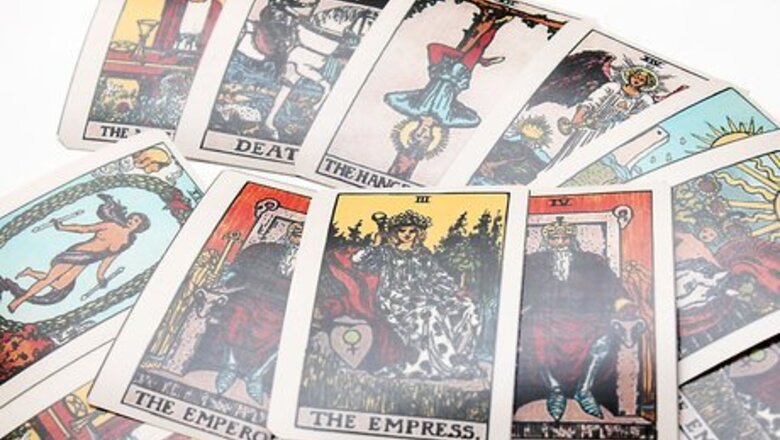
views
Preparing to Read
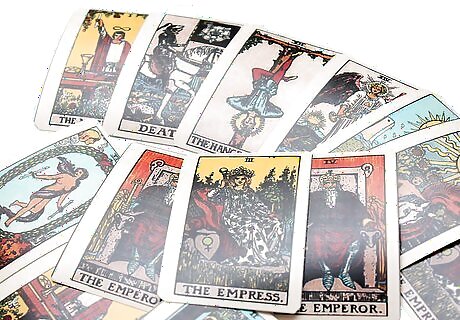
Choose your tarot deck. One of the most interesting aspects of tarot cards and tarot card reading is the number of tarot decks from which to choose. By and large the differences between any two decks will be cosmetic--the pictures or the names of the cards may differ. The vast majority of tarot decks will contain 78 cards of two parts: the Major Arcana (22 cards without an affiliated suit) and the Minor Arcana (56 cards, divided into 14-card suits). Tarot decks can usually be found at bookstores or occult shops. If you’re not in such a populated area, you may have to try ordering your deck online. The most common and recognizable tarot deck is the Rider-Waite deck. If you’re just starting out, consider choosing the Rider-Waite; many guides and books on tarot reading will involve the Rider-Waite almost exclusively. Again, the differences you’ll find between tarot decks will almost always be cosmetic ones. If you’d like to have your readings associated with a particular religion or brand of spirituality, there’s most likely a tarot deck with images and names to match that association. In terms of setting up, the sort of deck you choose will make no difference, unless the deck includes any explicit instructions to do otherwise than recommended here. It’s in reading that deck choice will really matter (a reason why the Rider-Waite is recommended to first-timers). You’ll draw different implications from decks which use differing images and names for their cards. Don’t be afraid to pick up and try multiple decks. Since they’re so interchangeable, there’s little risk of confusing yourself or mixing rules. Ultimately the choice is totally yours. Whether you intend to delve into divination or just want to entertain your friends, the choice of tarot deck is an entirely personal one.
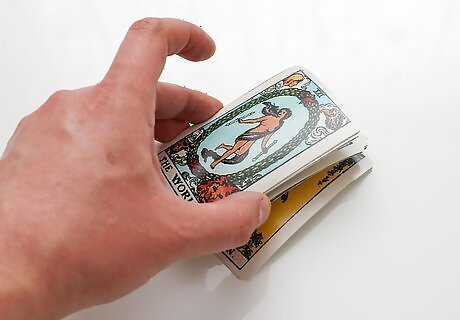
Prepare your deck. While the specifics of preparation will eventually depend on the “spread” (method of reading) you choose to use, most will involve shuffling your deck before beginning. Even before that, take time to look over the cards in your deck, recognizing which are Major and which are Minor Arcana. Be sure to remove any extra cards from the deck (blank or instructional cards) before setting your deck down to begin. While not every spread will demand the separation of the Major and Minor Arcana, you may want to anyway, if only to get a better sense of the different cards. Regardless of whether or not you’ll need to separate the Major/Minor Arcana, there’s no specific amount or type of shuffling you need to do. Do it as much (or as little) as you’d like.
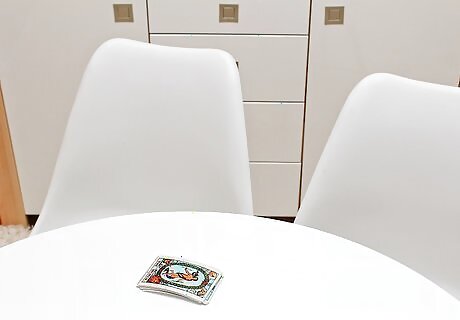
Find a suitable reading surface. The space required for a tarot reading will also depend on the spread which you eventually decide to use. Some spreads only call for a small surface in which to place a handful of cards, others call for significantly more space to form a circle of several cards. Do your best to match your reading surface to the purpose for a reading. If it’s a personal reading, find somewhere relaxing and comfortable where you can be at ease. If you’re reading for friends or to entertain, find a place with some space. Again, there’s no specific right or wrong when choosing a place to perform a reading. There’s also no rule saying it needs to be the same place twice. Don’t be afraid to move around if that’s what is comfortable for you.
Choosing a Spread
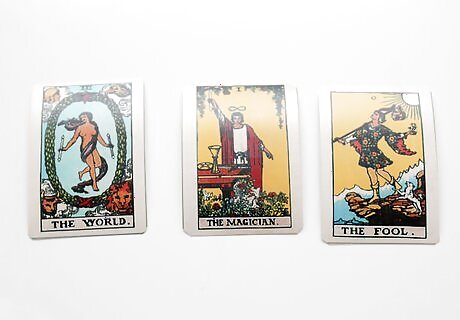
Use a three card spread. Traditionally the most common spread as well as the one most suggested for use by beginners, the three card spread is a simple one. This spread will require that you separate the Major and Minor Arcana cards from one another. Shuffle both decks before beginning (again, there’s no particular amount of shuffling you need to do). There are two variants to the three card spread, one including a Major Arcana card, and one which doesn’t. The included Major Arcana card is meant to aid interpretation, so consider including it for your first tries. For some foresight into reading, the single Major Arcana card which is included in the three card spread is a means of interpretation. Some guides including the three card spread choose to see the Major Arcana card included as representation of the person being read, others have it as a representation of the situation or question at hand. Not including the Major Arcana deck will make for a more stripped-down reading with a more narrow range of possible interpretation. If you are including a Major Arcana card, take the top card from the now-shuffled Major Arcana deck and place it face-up in front you. Then, take the three top cards of the Minor Arcana deck and lay them horizontally, left to right, underneath the Major Arcana card just placed. While the reading of the three card spread will differ depending on how you learn to read tarot, the three Minor Arcana cards will usually represent past, present, and future (in the order, from left to right). If you included a Major Arcana card, it will be the card through which the others are interpreted.
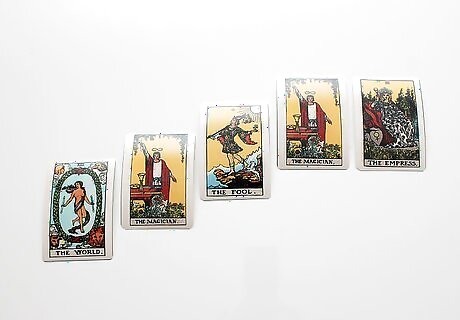
Try a five card spread. More refined than the three card spread, the five card spread is meant to inform on a specific course of action. Whereas the three card spread concerns the subject’s general situation, you’ll want to try the five card spread when the problem at hand can be summed as “what should I do?” This spread doesn’t separate the two Arcana types. Keep them shuffled together in one deck. Drawing from the top of the deck, place the first card in front of you (a card will be added on each of its four sides). This card will represent the present. The second card goes to the left of the first, and represents the past and its effect on the present. The third will go to the right, and represents the future. The fourth card will go below the first, and represents the reason for asking the question at issue. The fifth goes above the first, and represents the potential outcomes of the situation.
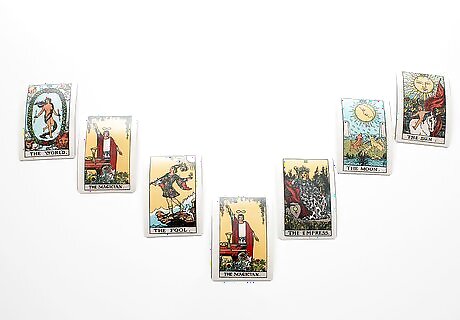
Use an ellipse spread. This spread will form a sort of crescent, or curve, of seven cards. Not quite as general as the three card spread but not as specific as the five card spread, the ellipse is best for interpreting any direct question (whether yes/no or otherwise). Like the five card spread, the ellipse doesn’t separate the minor and major Arcana, Keep them shuffled in one deck. From the top of the deck, place the first card to the far left of your playing surface. This card represents the past and its influence on the question. To the right of the first card and slightly lower on the table (closer to you) place the second card. This will represent the present. The third card will also go to the right and slightly lower, and it represents the concerns of the future. Again to the right and lower, place the fourth card which will be the center of the ellipse (the cards will be placed higher up now). It represents what to do in the current situation. Now to the right and higher on the table, place the fifth card. It will represent external forces affecting the situation. The sixth card will follow the pattern and it will represent the hopes and fears of the one being read for. The last card will be placed at the far right, completing the ellipse. It represents the ultimate outcome of this situation.
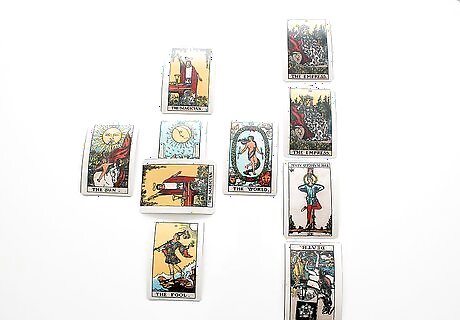
Try a celtic cross spread. A bit more involved, the celtic cross will take up more space than the three card spread, as it uses ten cards placed into a large pattern. It is a well-known spread. Though the method of interpretation will differ depending on how you learn to read tarot, the celtic cross is designed to answer specific questions. This spread does not require the separation of the Major/Minor Arcana, so combine both sets if separate, and shuffle well. The celtic cross is formed by two sections, one circle of six cards and one “staff” of four. Begin by placing the first card in front of you, and then the second card on top of that one, laying lengthwise. These two cards will represent the present and the challenges or obstacles faced in the present. The next card will be placed to the right of the two just placed, and the fourth card will be placed underneath the same two (both cards placed straight up). The card to the right represents the distant past, and the card underneath signifies the recent past. The fifth card placed will be placed above the central two cards, and the sixth will be placed to the left. The fifth one placed will represent the optimal outcome of the question, and the sixth represents the immediate future. To form the “staff” at the right of circle just formed, place four cards in a vertical row, starting at the bottom. The bottom-most card (the seventh) will represent the factors affecting the question at hand, the next card up (the eighth) represents external influences on the question. The ninth represents the asker’s hopes and fear, and the tenth and final card represents the eventual outcome of the question. Because this guide only outlines how to set up tarot cards, any resources you use to learn to read may offer alternate methods of reading the celtic cross.
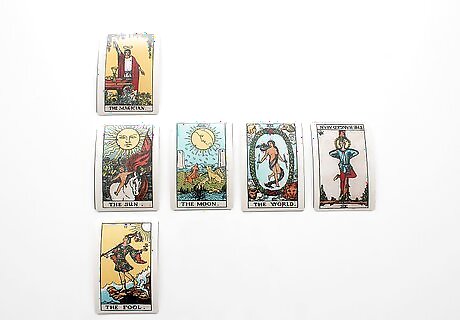
Invent your own spread. Because tarot is so personal and representative of the reader and the person being read for, there’s no “wrong” spread to use for a reading. You may feel existing spreads don’t provide the right amount of representative cards or the right variety of representation. Feel free to try any number of variations on old or new spreads you find. Try experimenting with existing spreads by including or separating Major and Minor Arcana cards before placing your spread. Listen to your intuition as you lay your cards out, and visualize how they feel. Set an intention for each card and listen to what that placement means. Tarot doesn't have to be rigid, it can be creative and fun if you allow your imagination the freedom to create.




















Comments
0 comment